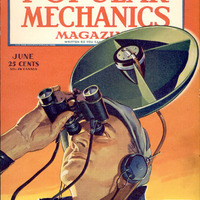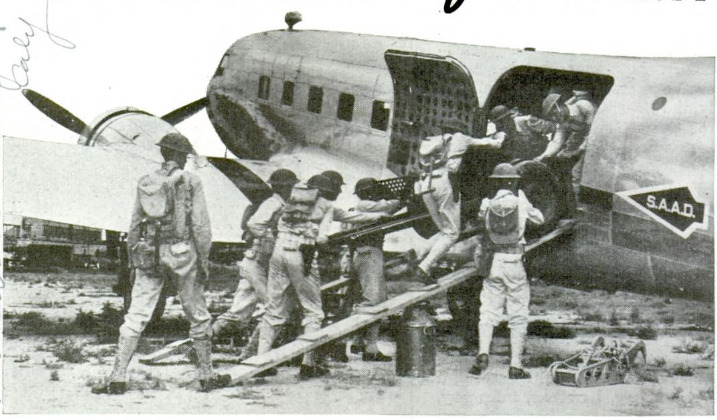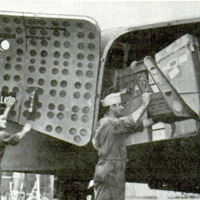ONE of the biggest, busiest and most rapidly expanding airlines in the country is the 50th Transport Wing, which is a freight and passenger-carrying section of the U. 8. Army Air Forces. Daily its big two-motored Douglas planes shuttle back and forth across the country or fly over mountains, jungle and blue water to reach such outlying bases as Newfoundland, Puerto Rico, the Panama Canal and Alaska. The line flies as much freight as 19 other major airlines and it stands fifth in the number of passengers carried. Its planes have taken off on schedule for the past six years in storm, snow and fog, but it has never lost the life of a passenger or pilot through accident. In other wars the U. S. Army has been content to rely on plodding mules, slow freight trains or lumbering trucks. But in this age of mechanjzed speed it has turned to air transportationi - which is about four times as swift as rail transportation. One of the 50th Transport Wing’s major jobs in the past three years has been to fly airplane parts and supplies from manufacturers to assembly factories working on government contracts. The Army wants planes in a hurry, and it's willing to do its share to help “get ‘em into the blue.” Likewise, the 50thTransport Wing carries propellers, motors, gas tanks, wing sections, landing gear and other necessary spare parts to outlying Army bases. As war needs demand, its cargo may be machine guns, light artillery, ammunition, blitz buggies or motorcycles. Army officers, engincers and civilian advisors ride the Army air line from coast to coast. Many precious days spent in transit are thus saved. Another of its jobs is to carry parachute troops. Organized in 1935, the U. S. Army transport organization consisted then of four squadrons - each equipped with two C-27 Bellanca Airbuses. In 1936 the squadrons were augmented by two Douglas DC-2's per squadron. In 1938 speeds and payloads were again boosted with the addition of 24 Douglas DC-3's. In that year, too, the service was extended to include regular interdepot flights and subsequent coast to coast flights. At present the 50th Transport Wing has a large number of transport planes basically similar to the Douglas DC-3's which fly commercial airlines throughout America. The number is increasing and when a new Douglas plant gets into full operation hundreds of new C-47’s will be added. Commercial planes are like huge, silvery birds, but the Army’s “flying mules” are drab and colorless with camouflage. Inside, though structurally similar to the passenger planes, the Army transports lack soundproofing, deep upholstering, and interior decorations which have made American commercial planes the last word in luxury. The transports, bare and utilitarian, are built for work. The floors and sides of the cabins are sturdily reinforced with heavy sheet metal to support the heaviest of loads. Special fittings make it possible to bolt and lash down cargo. More than 7,000 pounds of freight can be carried in a single plane. Each plane is equipped with its own portable crane and hoist so that loading and unloading can be done by the crew’s members, if necessary, without ground equipment. Doors are extra large so that cargo can be loaded and unloaded quickly. When propellers are carried, they are lashed to the underside of the wings instead of being stored inside the plane. ‘Wright Field, Dayton, Ohio, is headquarters and “nerve center” for the 50th Transport Wing. Here, flight schedules are made up and teletype communication is maintained with the other Army depots throughout the continental United States. When a plane sets out on a flight, it is spotted on the routing board and its movements are followed through the entire flight. This enables headquarters to keep a close check on all planes at all times. A regular schedule of flights is maintained from Wright Field to Fairfield Air Depot, Fairfield, Ohio; Middletown Air Depot at Middletown, Penn.; Sacramento Air Depot at Sacramento, Calif.; San Antonio Air Depot at San Antonio, Tex.; Ogden Air Depot at Ogden, Utah; and Mobile Air Depot, Mobile, Ala. Under construction are several more large supply and regular depots, each of which will be served by regular freight schedules of the 50th Transport Wing. For some time there have been regular, 2,116-mile flights from San Antonio to air depots in the Canal Zone. Flights from Sacramento to Alaska and trips to Newfoundland and Puerto Rico also are made. The 50th Transport Wing takes its pilots from the young men who have won their wings at Kelly Field, the Army’s advanced flying school in Texas. It picks men whom it thinks will make the best “big ship” pilots - steady, cool-nerved men instead of the impulsive, daring chaps who will make better fighter pilots. Precise information on the activities of the 50th Transport Wing is a military secret, but figures for 1940 indicate the bustling growth of this airline. Some 13,311,000 pounds of cargo were moved, some 5800 passengers carried, a total of 2,615,573 miles flown, 5,019,691 ton-miles flown and 2,377,933 passenger-miles flown representing 100 to 200 percent increase over 1939. And 1941’s figures probably would show a similar increase over 1940. Let’s picture a typical flight. A drab-colored two-motored transport has just been overhauled at the Middletown, Penn., depot. The teletype chatters out this message from Wright Field: “Proceed to Fairfield depot. Pick up motors, propellers and gas tanks for San Antonio.” The Army-trained pilots get into their flying gear and the transport trundles down the field and slips into the air. After about two hours of flying the big ship reaches the Fairfield depot. As soon as it lands trained crews start loading. Engines on mobile shipping cradles are whisked out of the hangars and hoisted into the plane, propellers are mounted on special underwing carriers, and smaller articles are stowed away where space can be found. The businesslike manner in which the plane is loaded is a lesson in military efficiency and co-ordination. As the plane nears St. Louis, however, another message comes by radio: “Proceed to Kansas City. Leave cargo there and pick up aluminum castings for Santa Monica.” This change in orders is nothing novel to the pilots who fly the Army transports. Frequently load changes are made to rush material of a higher priority to places where it is sorely needed. The motors, propellers and gas tanks will be shipped to San Antonio on the next plane.
 Popular Mechanics, vol. 77, n. 6, 1942
Popular Mechanics, vol. 77, n. 6, 1942





